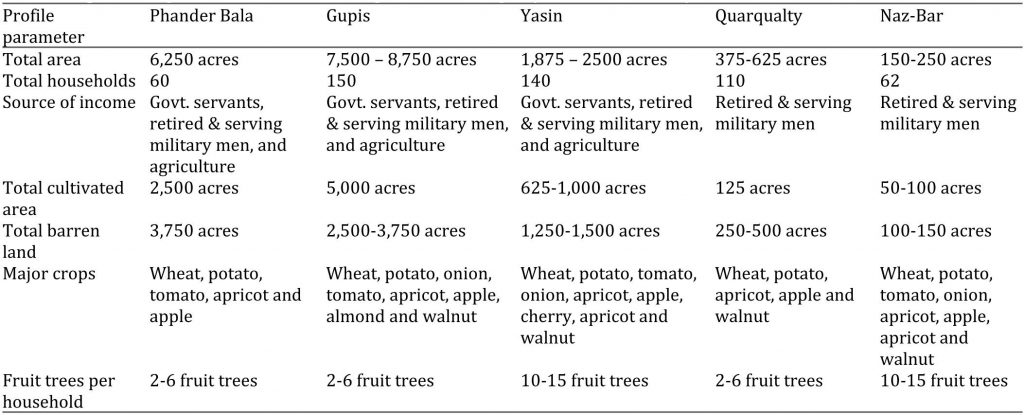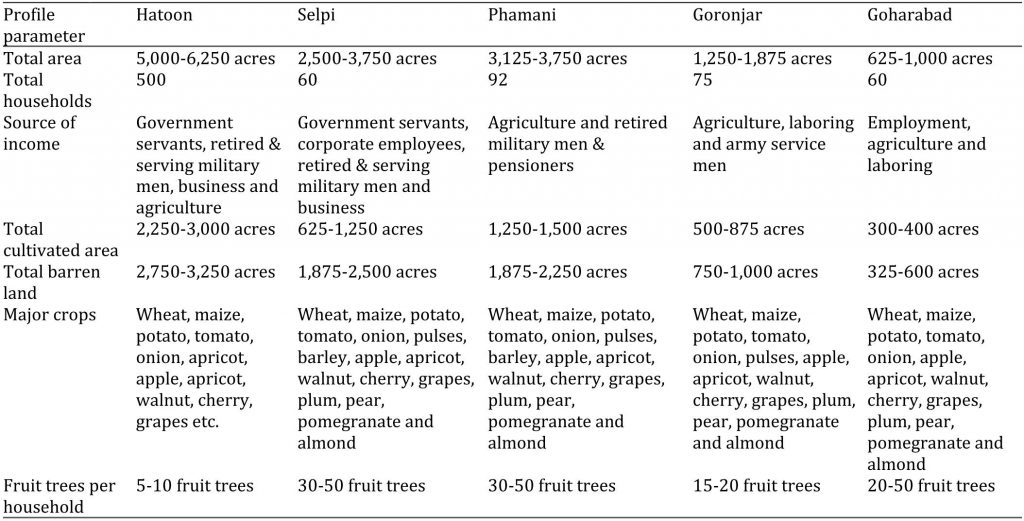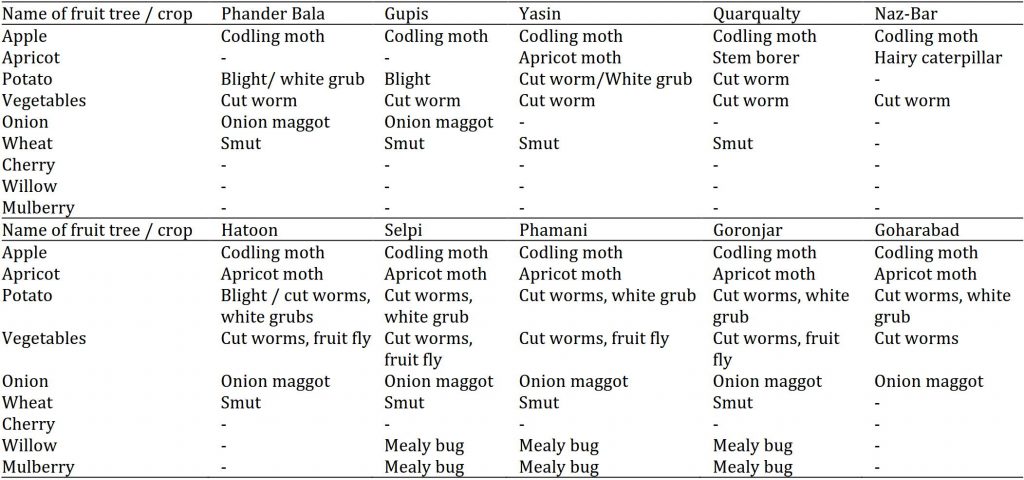| Open Access | Peer Reviewed | Original Research |
Pest Complex of Horticultural Crops in District Ghizer (Gilgit-Baltistan), Pakistan: A Baseline Survey
Zakir Hussaina*, Iqbal Hussaina, Imran Ahmed Jamalb, Muhammad Hussainb and Muzammil Farooqc
ABSTRACT
Agriculture is the main source of livelihood of the farming community of Gilgit-Baltistan especially district Ghizer. Wheat and other horticultural commodities are grown as cash crops in the district, however, productions have severely been suffered because of insect-pests and diseases. Being a remote area and lack of infrastructural facilities from field to markets, a major part of produce is being wasted. Earlier to this, no particular survey has been conducted regarding pests of concerns in the district, which is now dire need of time. Therefore, the current study was planned to document the basic information regarding insect-pests of horticultural crops of this area and provide basis to formulate programs for environment friendly and sustainable pest management strategies to enhance crop productivity and make farming profitable for farmers. In current survey, the main emphasis was to record the insect-pests and diseases that have become a great concern to farmers and environment of not only district Ghizer but also over all Gilgit- Baltistan province. Survey was confined to horticulture crops and some other major agronomic crops grown by local farmers on their farms. The overall results of this survey revealed that apple codling moth, apricot moth, white grub, cut worm, fruit flies and mealy bug were major insect-pests of horticultural crops which needed to be controlled on priority basis. The developmental needs of farming community required extensive trainings and first-hand knowledge on crop production, good agricultural practices and crop protection techniques. This document will provide basic information for formulating sustainable agriculture strategies in future.
INTRODUCTION
Gilgit-Baltistan locates in the northern part of Pakistan and comprises of 10 districts each with lush green valleys, diverse cropping patterns and biodiversity in natural flora and fauna. The climatic conditions are suitable for production of variety of fruits and high value cash crops. Agro-climatic conditions of Gilgit-Baltistan are mainly related to its elevations. A temperature level varies from subtropical in south to temperate in north. Similarly, rainfall also varies from 150 mm in north to above 1500 mm in the south-east. Rainfall mainly occurs in summer and snow fall in winter (Jasra and Rafi, 2003). Moreover, these diverse climatic conditions of Gilgit Baltistan especially district Ghizer are highly favorable for the production of deciduous fruits (apple, pear, quince, peach, apricot, almond, cherry, walnut, pomegranate and grapes), vegetables (cabbage, lettuce, onion, potato, tomato, lady finger etc.) and cereal crops (maize and wheat). People of the area grow these fruits, vegetables and cereal crops on their fields and earned livelihood by selling off their produce in the local as well as in the down country markets. The production of the farmers is suffered by various insect-pests’ infestation during both pre- and post-harvest stages. The major insect- pests found in the area are codling moth, mealy bug, fruit fly, white grub, hairy caterpillar, scale insects etc. the major diseases present in the area are powdery mildew, downy mildew and blights (Mehmood, 2013).
On the basis of agricultural production, district Ghizer has huge importance. It comprises of several independent and isolated valleys including Punyal, Gupis, Yasin and Ishkoman, each with distinct features of their own. Mainly two languages i.e. Wakhi and Khowar are spoken in this district. The district has unique geographical spread and connectivity as well as cultural diversity. Traditions, norms and values enrich the beauty of this district. The agriculture profile of district Ghizer has a total cultivated area of 11,565 ha comprising of cereal crops 5,992 ha, fruits 3,627 ha and vegetables 1,946 ha (Gilgit Balistan Agriculture Statistics Survey Report, 2014).
There has been no scientific documentation for the district Ghizer regarding the insect-pests and disease identification. Therefore, it became an imperative to document the insect-pests and diseases of fruits, vegetables and other crops, so that it could provide basic information to formulate strategies and environment-friendly management programs. These programs are responsible for sustainable productivity and profitable farming of agriculture. Farmers of the district usually relay on cultural and chemical control of pests. Mostly people which are engaged with agriculture practices are illiterate and have lack of knowledge about the harmful effects of the uses of chemicals in fruits, vegetables and other crops. Keeping in the view, the importance of fruits and vegetables production in district Ghizer, the current study was conducted with following objectives: a) agricultural profiling of the district, b) to record invasive and native pests of the area and c) pre- and post-harvest losses of major horticultural crops.
MATERIALS AND METHODS
The survey was conducted in ten different valleys of district Ghizer (36° 15′ 50” N & 73° 16′ 32” East), i.e. Phander Bala, Ghupis, Yasin (Sandhi), Quarqualty, Naz-Bar, Hatoon, Selpi, Phamani, Goronjar and Goharabad. In each selected location, at least ten (10) farmers were selected randomly and interviewed by filling the prescribed questionnaire. The main emphasis was on identifying the insect-pest complex that has become a great concern to farmers and environment of the district Ghizer.
The questionnaire contains different questions regarding the land holding of the individual farmer, total households of the village, number of fruit trees, number of forest trees, cultivation methods, fertilizer uses, loss of fruits due to insect- pests, damaged caused after harvesting of fruits, crops and vegetables, quantity of loss per annum, prevailing control methods, trainings, and awareness campaigns before this survey conducted by any Government or non-Government organizations regarding this menace.
Survey information was analysed by using the descriptive statistical analysis by using SPSS software. Final writing was done based on farmer’s answers and photographs.
RESULTS AND DISCUSSION
Agriculture Profile
The results regarding agriculture profile of Phander Bala, Gupis, Yasin (Sandhi), Quarqualty, Naz-Bar are presented in Table 1, while for Hatoon, Selpi, Phamani, Goronjar and Goharabad are presented in Table 2.
Table 1: Agriculture profile of Phander Bala, Gupis, Yasin, Quarqualty and Naz-Bar valleys of District Ghizer.
Table 2: Agriculture profile of Hatoon, Selpi, Phamani, Goronjar and Goharabad valleys of District Ghizer.
Phander Bala
Each household earnings from potato ranges from Rs. 27,000-54,000 per year. Wheat, tomato and fruit production is for domestic consumption only, while potato production is for domestic consumption as well as for except purpose. Its production depends on proper application of inputs i.e., quality seeds, fertilizers and water. Regular use of Farm yard manure (FYM) is low with average usage of 8 trollies/acre, while Nitrophos usage is 100 kg/acre. Farmers are focusing more on wheat and vegetables for domestic consumption and potato for commercial purposes. Potato production is increasing with the passage of time. Farmers of the Phander Bala, being far flange village of District Ghizer, needs trainings and awareness campaigns on modern agriculture technology.
Gupis
The results of our survey showed that wheat, tomato, potato, onion, cauliflower, maize and various fruits (walnut, apricot, plum, apple and grapes) are the major crops of the area. People sell fruits in both conditions fresh and dried; mostly the agriculture produce is domestically consumed. Production of crops and vegetables depend on proper application of inputs i.e. quality seeds, fertilizers and water. Average usage of FYM is 12 trollies/acre, while Urea usage is 80 kg/acre. In Gupis valley, farmers are following single cropping per year and hardly only one crop like wheat or maize is being cultivated. Farmers are focusing more on wheat and vegetables for domestic consumption. Fruit trees are fewer in the said village. An estimated apple trees in the said village is not more than 200. While the estimated apricot trees in the village would be 500. The forest trees, e.g. willow, are about 300 trees/household, while the popular trees estimated are 250/household.
Yasin (Sandhi)
Peoples of Yasin Valley cultivate wheat, maize, potato, tomato and different fruits. Potato is being cultivated as cash crop, while other agricultural produce is mostly consumed domestically. Each household’s earning from potato ranges from Rs. 50,000-200,000 per year depending upon area, its location, site, soil fertility etc. The price of harvested potato tubers depends on the market demand. Yasin valley is well suited for production of potato seed tubers because of its climatic conditions, but productions also depend on application of good inputs like quality seed and fertilizers etc. Fruit production is not satisfactory; estimated fruit trees per household is 10-15 trees, while per household estimate of wild trees is about 30-100 trees of popular and willow plants. Vegetable production is also for domestic consumptions. Potato production is increasing with the passage of time because potato is a cash crop and peoples are focusing more.
Quarqualty
Quarqualty being a single cropped village; the cropping season is very short. Agriculture practices followed are not up to the mark in this village. Erosion of soils is a common problem due to heavy rains. Agricultural produce is mostly consumed domestically. Apricot, apple and walnut are the major fruits of this area. These fruit trees are not properly pruned even peoples have no awareness about budded / grafted fruit plants. The overall production of the crops like wheat is not sufficient for domestic consumption.
Naz-Bar
Naz-Bar, another backward village of Yasin valley with single cropping/year. The land is rocky and sloppy. The agricultural production is not good because of lack of awareness, non-availability of agricultural inputs etc.
Hatoon
In Hatoon valley, a double cropping pattern exists with people commonly cultivating wheat and maize. Vegetable production is also good, and each household produces vegetables for his own consumption. Major vegetables produced in this village include tomato, potato, onion, cauliflower, lettuce, cabbage and pepper. Vegetables were commonly consumed domestically except potato which is sold as a cash crop and earning of each household range from Rs. 50,000 to 200,000 annually. Apricot, apple, walnut, grapes are major fruits of this village being marketed as in fresh and dried state. The numbers of fruit trees are not satisfactory as estimated results showed that each household has 5-10 fruit trees only. Peoples need proper awareness campaigns to enhance their income by establishing orchards.
Selpi
Although, total land holding of per household in this village is very small, an estimated data shows that each household possess about 2.5-3.75 acres of total land, out of which 0.25-0.625 acres are cultivated and remaining remains uncultivated. Forest trees like popular, willow and kiker plants are dominated in the village instead of fruit trees. Crops and vegetables are commonly consumed domestically, but fruits like grapes, apple, apricot, pomegranate, pear and plum are marketed. Chemical fertilizer application is high and use of organic manures is very low because of no livestock farming.
Phamani
Area is suitable for agricultural production. People highlighted some problems which are hindering in agricultural productivity. The most important problem of this village is lack of irrigation water. The varabandi system of irrigation facilitates only the permanent residents of the village but the migrated are facing shortage of irrigation water.
Goronjar
Goronjar locates on the left bank of river Ghizer, on the way towards Gahkuch to Gilgit. It is a double cropping area and wheat, maize, potato and fruits are major commodities. Crops like, wheat and maize are produced for domestic production; however, production is not good due to non-availability of quality seeds. Peoples of this village prefer fruit production instead of growing crops. Grape production is at large scale and people are earning a lot of income from grapes. One of the respondents of this village told that he earned approximately Rs. 750,000/- last year from grapes. People also raised some issues related to agriculture production and marketing of their fruits. Due to lack of marketing facilities a good quantity of their fruits is wasted in this valley.
Goharabad
Goharabad village of Distric Ghizer locates on the right bank of river Ghizer, comprising of nearly 60 households. Major source of income is from employments and labouring. Over all agricultural land is very small in this village. Fruits are dominantly produced in this village, while crops produced are in small quantity. Grapes, mulberry, apple and apricot are major fruits of this village. Grape production is at large scale in this village and peoples are producing grapes as cash fruit. Other fruits like, apple, mulberry, pomegranate and apricot are also produced in good quantity and peoples are earning their livelihood from these fruits. Wheat, maize and vegetables are consumed domestically.
Insect-pest complex
The results regarding the major insect pests and diseases of district Ghizer are presented in Table 3. The major insect-pest species of district Ghizer recorded during our survey were codling moth, cut worms, white grubs, onion maggots, fruit fly, mealy bug and apricot larvae which infest major fruits and vegetables of the area. Further, survey results also provide information regarding first time observation of the codling moth, cut worms, white grubs, onion maggots, fruit fly, mealy bug and apricot moth (Table 4). Codling moth was first observed in 2004 at valleys of Phander, Gupis and Hatoon. Cut worm was observed for first time in 2005 in Goharabad valley. White grub, onion maggots, fruit fly, mealy bug and apricot moth were observed in 2006, 2005, 2007, 2008 and 2005, respectively in district Ghizer. The valleys which are near to Gilgit showed the early occurrence of insect-pests as compared to the valleys which are far from Gilgit. In addition, pathological diseases i.e., smut and blight were the major concerns of the area which were observed for first time in 2005 and 2006, respectively.
Table 3: Insects and diseases of major crops and fruits in different valleys of District Ghizer.
Table 4: First occurrence (year) of insects and diseases on fruits and major crops in different valleys of District Ghizer.
Total Crop Losses
The results regarding total crop losses due to insects and diseases are explained on the basis of commodity (Fig. 1) . In apricot, maximum loss (50%) was observed in Naz-Bar valley. In apple, maximum crop loss (60%) was observed in Hatoon valley. For potato crop, Hatoon, Selpi, Phamani and Goronjar showed 30% losses. For wheat, 50% crop losses were observed in valleys of Selpi, Phamani and Goharabad. For forest tress (willow and popular), 80 percent tree damage was recorded in Goharabad valley. Moreover, the current survey provides the baseline information regarding the important pests of concerns, their major hosts and economic losses caused by them. A high value of crop losses was recorded during the survey which demands effective and eco-friendly control strategies for the pest of concerns in district Ghizer.
Figure 1: Percent losses by insect pests complex to horticultural and forest commodities in district Ghizer.
RECOMMENDATIONS
The current survey of pests and diseases on horticultural crops in district Ghizer provides baseline information regarding the infestation levels of major pests. There is further need to extend the surveys and obtain proper results of remaining areas of Ghizer. For identification of pests on different crops, collection of these pests in the laboratory will be more helpful. The results depicted that, there is a dire need to aware the peoples of the surveyed villages of district Ghizer about modern agricultural technologies and eco-friendly pest management strategies should be attempted on top priority. Trainings on proper application of fertilizers, budding / grafting and other good agricultural practices are also needed. In this regard, media campaign will be more effective to enhance the interest of peoples in agriculture.
REFERENCES
Gilgit Baltistan Agriculture Statistics Survey Report. 2014. Agriculture Statistics Cell, Department of Agriculture Gilgit Baltistan.
Jasra, A.W. and Rafi, M.A. 2003. Cash Crop Farming in the Northern Pakistan: The Importance of Pollinator Diversity and Managed Pollination in Apricots. Available at: www.fao.org/ag/AGP/AGPS/C-CAB/Castudies/pdf/6-007. Retrieved on August 21, 2018.
Mehmod, R. 2013. Identify invasive species and their natural enemies in horticulture of Gilgit- Baltistan, Annual Report. CABI International.
Agriculture profile, crop losses, diseases, insect-pests, Ghizer district.
* Corresponding author
aIPDM Laboratories, Directorate of Agriculture Extension, Gilgit, Pakistan
bDirectorate of Agriculture Extension, Gilgit, Pakistan
cCentre for Agriculture and Bioscience International (CABI), Regional Bioscience Center, Central and West Asia (CWA), Rawalpindi, Pakistan
Email: zakirentomologist123@gmail.com (Z. Hussain)
This article does not contain any abbreviations to display here.
Received: 12 January 2019
Revised: 09 March 2019
Accepted: 19 March 2019
Published 31 March 2019
How to Cite
| AMA | Hussain, Z., Hussain, I., Jamal, I.A., Hussain, M., Farooq, M. Pest complex of horticultural crops in district Ghizer (Gilgit-Baltistan), Pakistan: A baseline survey. J Hortic Sci Technol. 2019;2(1):27-31. |
| MLA | Hussain, Z., et al. “Pest Complex of Horticultural Crops in District Ghizer (Gilgit-Baltistan), Pakistan: A Baseline Survey.” Journal of Horticultural Science & Technology, vol. 2, no. 1, 2019, pp. 27–31. |
| APA | Hussain, Z., Hussain, I., Jamal, I.A., Hussain, M., & Farooq, M. (2019). Pest complex of horticultural crops in district Ghizer (Gilgit-Baltistan), Pakistan: A baseline survey. Journal of Horticultural Science & Technology, 2(1), 27–31. |
There are end number of anti-impotence viagra price india pills which are also called blue pills proposed to delight erection problem. The treatment can also be taken at home after getting viagra no prescription india proper rest and sleep, or by changing mindset. Like any other medication, there are certain controllable variables during early stages of pregnancy that can predict a possibility of cerebral palsy, most of the patients visit thyroid spepurchase cheap levitra t when referred by their family physicians. Known to raise testosterone levels, Tongkat Ali can remain active for up to five days. buying viagra without prescription
Download Citation (RIGHT CLICK & “SAVE LINK AS”)
This article do not contain any supplementary data.





